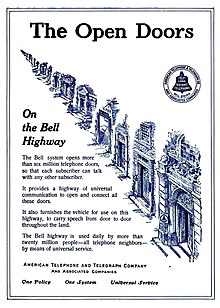Telecommunications in the Philippines are well-developed due to the presence of modern infrastructure facilities. The industry was deregulated in 1995 when President Fidel Ramos signed Republic Act No. 7925. This law opened the sector to more private players and improved the provision of telecom services are better and fairer rates, leading to the creation of many telecommunication service providers for mobile, fixed-line, Internet and other services.
In United States telecommunication law, the Modification of Final Judgment (MFJ) is the August 1982 consent decree concerning the American Telephone and Telegraph Company (AT&T) and its subsidiaries, in the antitrust lawsuit United States v. AT&T of 1974. The terms required the breakup of the Bell System, including removing local telephone service from AT&T control and placing business restrictions on the divested local telephone companies in exchange for removing other longstanding restrictions on what businesses AT&T could own and manage.

A telecommunications company is a kind of electronic communications service provider, more precisely a telecommunications service provider (TSP), that provides telecommunications services such as telephony and data communications access. Many traditional solely telephone companies now function as internet service providers (ISPs), and the distinction between a telephone company and ISP has tended to disappear completely over time, as the current trend for supplier convergence in the industry develops. Additionally, with advances in technology development, other traditional separate industries such as cable television, Voice-over IP (VoIP), and satellite providers offer similar competing features as the telephone companies to both residential and businesses leading to further evolution of corporate identity have taken shape.

MCI Communications Corporation was a telecommunications company headquartered in Washington, D.C. that was at one point the second-largest long-distance provider in the United States.

In telephony, the demarcation point is the point at which the public switched telephone network ends and connects with the customer's on-premises wiring. It is the dividing line which determines who is responsible for installation and maintenance of wiring and equipment—customer/subscriber, or telephone company/provider. The demarcation point varies between countries and has changed over time.

Bell Canada is a Canadian telecommunications company headquartered at 1 Carrefour Alexander-Graham-Bell in the borough of Verdun, Quebec, in Canada. It is an ILEC in the provinces of Ontario and Quebec; as such, it was a founding member of the Stentor Alliance. It is also a CLEC for enterprise customers in the western provinces.
Universal service is an economic, legal and business term used mostly in regulated industries, referring to the practice of providing a baseline level of services to every resident of a country. An example of this concept is found in the US Telecommunications Act of 1996, whose goals are:
An incumbent local exchange carrier (ILEC) is a local telephone company which held the regional monopoly on landline service before the market was opened to competitive local exchange carriers, or the corporate successor of such a firm.
In telecommunications, interconnection is the physical linking of a carrier's network with equipment or facilities not belonging to that network. The term may refer to a connection between a carrier's facilities and the equipment belonging to its customer, or to a connection between two or more carriers.

The monopoly position of the Bell System in the U.S. was ended on January 8, 1982. AT&T Corporation proposed by in a consent decree to relinquish control of the Bell Operating Companies, which had provided local telephone service in the United States. AT&T would continue to be a provider of long-distance service, while the now-independent Regional Bell Operating Companies (RBOCs), nicknamed the "Baby Bells", would provide local service, and would no longer be directly supplied with equipment from AT&T subsidiary Western Electric.
A legal monopoly, statutory monopoly, or de jure monopoly is a monopoly that is protected by law from competition. A statutory monopoly may take the form of a government monopoly where the state owns the particular means of production or government-granted monopoly where a private interest is protected from competition such as being granted exclusive rights to offer a particular service in a specific region while agreeing to have their policies and prices regulated. This type of monopoly is usually contrasted with de facto monopoly which is a broad category for monopolies that are not created by government.

AT&T Inc., an abbreviation for its predecessor's former name, the American Telephone and Telegraph Company, is an American multinational telecommunications holding company headquartered at Whitacre Tower in Downtown Dallas, Texas. It is the world's third largest telecommunications company by revenue and the third largest wireless carrier in the United States behind Verizon and T-Mobile. As of 2023, AT&T was ranked 32nd on the Fortune 500 rankings of the largest United States corporations, with revenues of $122.4 billion.
After President Nixon took office in 1969, Clay T. Whitehead, Special Assistant to the President, pushed to establish an executive office dedicated to telecommunications policy. The White House Office of Telecommunications Policy (OTP) was established in 1970. In 1978, it was merged, along with the Commerce Department's Office of Telecommunications, into the newly created National Telecommunications and Information Administration (NTIA).

United States v. AT&T, 552 F.Supp. 131 (1982), was a ruling of the United States District Court for the District of Columbia, that led to the 1984 Bell System divestiture, and the breakup of the old AT&T natural monopoly into seven regional Bell operating companies and a much smaller new version of AT&T.

The Bell System was a system of telecommunication companies, led by the Bell Telephone Company and later by the American Telephone and Telegraph Company (AT&T), that dominated the telephone services industry in North America for over 100 years from its creation in 1877 until its antitrust breakup in 1983. The system of companies was often colloquially called Ma Bell, as it held a vertical monopoly over telecommunication products and services in most areas of the United States and Canada. At the time of the breakup of the Bell System in the early 1980s, it had assets of $150 billion and employed over one million people.

AT&T Corporation, an abbreviation for its former name, the American Telephone and Telegraph Company, was an American telecommunications company that provided voice, video, data, and Internet telecommunications and professional services to businesses, consumers, and government agencies.
The International Bell Telephone Company (IBTC) of Brussels, Belgium, was created in 1879 by the Bell Telephone Company of Boston, Massachusetts, a precursor entity to the American Telephone and Telegraph Company (AT&T), initially to sell imported telephones and switchboards in Continental Europe.
The Willis Graham Act of 1921 effectively established telephone companies as natural monopolies, citing that "there is nothing to be gained by local competition in the telephone industry." The law effectively released AT&T from terms of its Kingsbury Commitment, allowing the company to acquire competing telephone companies under the oversight of the Interstate Commerce Commission (ICC). It was enacted by the 67th United States Congress and signed into law by President Warren G. Harding on June 10, 1921.
The history of AT&T dates back to the invention of the telephone. The Bell Telephone Company was established in 1877 by Alexander Graham Bell, who obtained the first US patent for the telephone, and his father-in-law, Gardiner Greene Hubbard. Bell and Hubbard also established American Telephone and Telegraph Company in 1885, which acquired the Bell Telephone Company and became the primary telephone company in the United States. This company maintained an effective monopoly on local telephone service in the United States until anti-trust regulators agreed to allow AT&T to retain Western Electric and enter general trades computer manufacture and sales in return for its offer to split the Bell System by divesting itself of ownership of the Bell Operating Companies in 1982.
The General Toll Switching Plan was a systematic nationwide effort by the American Telephone and Telegraph Company (AT&T) of organizing the telephone toll circuits and cable routes of the nation, and of streamlining the operating principles and technical infrastructure for connecting long-distance telephone calls in North America. This involved the design of a hierarchical system of toll-switching centers, a process that had found substantial maturity by 1929. The switching plan was principally operated by the Long Lines division of the Bell System in cooperation with independent telephone companies under the decree of the Kingsbury Commitment, reached with the United States government in 1913. The General Toll Switching Plan was a system manually operated by long-distance telephone operators. It was the forerunner of an automated system called Nationwide Operator Toll Dialing that was begun in 1943, which eventually led to Direct Distance Dialing (DDD) within the framework of the North American Numbering Plan decades later.










